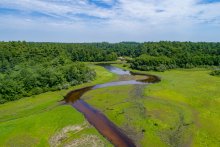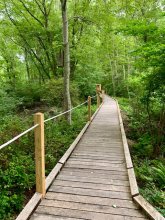Celebrating Our Restoration Successes – 20 Years after the B-120 Buzzards Bay Oil Spill
April 27, 2023
Nestled behind the elbow of Massachusetts’ famed Cape Cod, Buzzards Bay is equally iconic in its New England character. The Bay’s clear blue waters, diverse marine life and beautiful landscapes draw thousands of tourists each year for boating, swimming, birdwatching and fishing.
But 20 years ago, disaster struck along the picturesque coastline: the barge Bouchard 120 ran aground on a ledge of bedrock on April 27, 2003. A 12-foot gash in its hull released 98,000 gallons of fuel oil, polluting nearly 100 miles of Massachusetts and Rhode Island shorelines. The spill damaged many saltmarshes and other coastal habitats, killed and injured shellfish, terns, loons, and other bird species, disrupted ecological processes, and closed local shellfishing and other daily public use of coastal resources within the spill area.
Today, Buzzards Bay is transformed, through dedicated efforts of scientists and specialists who assessed the impacts of the spill along the coast and a multitude of natural resources, case teams who worked to build a legal case to hold the responsible party liable for the spill damages, and habitat restoration experts who have led many projects to address and compensate for the spill damages.
With more than $19.3 million secured for restoration projects through a legal case settlement, Trustees including NOAA, the U.S. Fish and Wildlife Service, the Commonwealth of Massachusetts, and the State of Rhode Island have worked to complete important natural resource restoration. With a diverse array of partners (for example, the Town of Wareham), the last two decades of work has helped to restore fish, wildlife and birds, and public uses impacted by the spill. Some of the highlighted projects are as follows:
Fish
Projects to support healthy, sustainable fish populations included the removal of the Horseshoe Mill dam and restoration of the Weweantic River in Wareham, Massachusetts to restore 90 acres of wetlands as fish habitat and re-open three miles of stream habitat to river herring and other migratory fishes. Additional projects completed to support fish populations include the removal of migratory fish passage barriers and wetland restoration on Red Brook, as well as a construction of a fishway on Factory Brook in South Kingstown, Rhode Island to further support the needs of migratory fish using coastal streams for spawning in this region.
Aquatic Habitat
Below the surface of Buzzards Bay, installation of more than 40 conservation moorings supporting eelgrass restoration in West Falmouth Harbor, and dedicated projects enhanced oyster habitat at multiple sites in the Bay. Conservation moorings are constructed with a retractable elastic cord, attached to a boat or mooring float and to the bottom anchor. The cord stretches or contracts depending on the daily tide heights, thus preventing scouring of the Bay bottom and loss of eelgrass that occurs with older, metal mooring chains lying on the bottom.
Birds
Many species of birds using Northeastern coastal waters rely on sandy beaches and rocky islands scattered across the Buzzards Bay. Restoration projects for bird species impacted by the spill included the protection and management of piping plover nesting habitat along beaches in Massachusetts and Rhode Island, and seven loon restoration projects applying various techniques throughout the Northeast, plus an ongoing assessment of potential projects to restore tern nesting and shoreline habitat.
Recreational Uses
Projects to restore lost public uses have addressed coastal access, boating and shellfishing in many Buzzards Bay communities.
For recreation, projects have included trail and boardwalk construction at the Nasketucket Bay State Reservation in Mattapoisett, MA and Allens Pond Sanctuary in Dartmouth, MA; trail improvements at Black Point in Narragansett, RI; and reconstruction of public boat ramps in Onset, RI and Dartmouth, MA as well as and installation of new kayak launches in Wareham, MA. Durable fabric “Mobi-mats” were also installed over sand accessways at three beaches to enable ease of beach access for all users.
Restoration has also included purchase of land for conservation and public access, including nearly 450 acres in Fairhaven, MA and Mattapoisett, MA and 300 acres on Cuttyhunk Island, MA.
Public recreational shellfishing areas were hard hit by the 2003 spill, and restoration activities helped to support recreational shellfishing. More than 24,000 bushels of adult hard clams were relayed from the Assonet River closed waters to provide recreational shellfishing and allow for increased spawning. With time to cleanse and reproduce, the effort provided additional recreational quahog harvesting opportunities. Additionally, a variety of shellfish seed programs helped replenish coastal waters for shellfishing, providing 1.76 million seed oysters, 497,000 hard clam seed, and over 18,000 bay scallops for spawner sanctuaries. The programs worked with local shellfish wardens to both grow and release shellfish to at least 53 Buzzards Bay sites.
While some work remains, the Trustees now celebrate many achievements, 20 years after the unfortunate Bouchard 120 oil spill. Many projects have been completed to contribute public benefits.
According to Branden Annett, Vice President of Watershed Protection at the BBC, “the Bouchard oil spill was a singular crisis for Buzzards Bay, but it did serve to coalesce regional organizations in a way that we had never seen before. It was also the impetus for a number of successful ecological restoration projects. I hesitate to say that they are bright spots in the oil spill story, but current and future generations will have access to these restored resources and protected shorelines of the Bay because of the coordinated response.”








